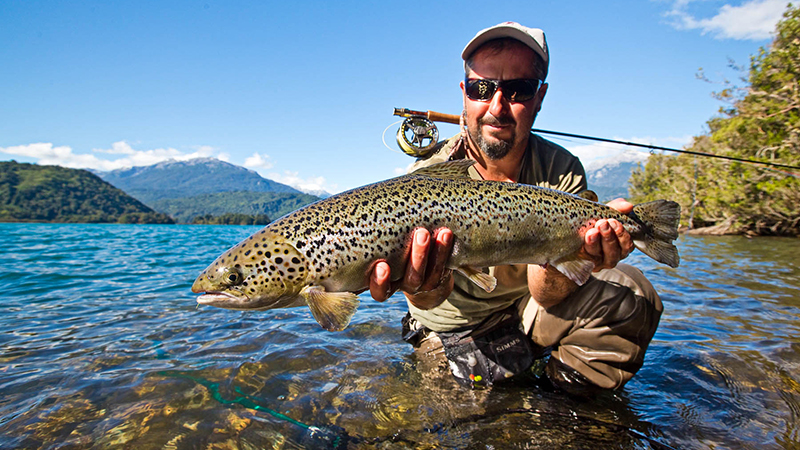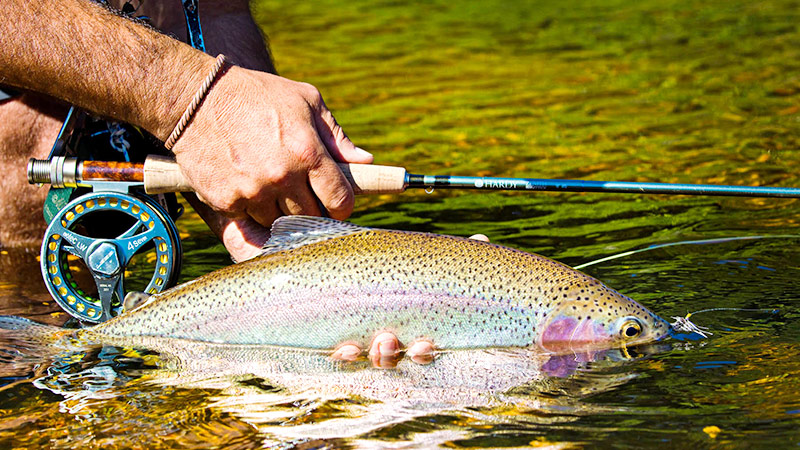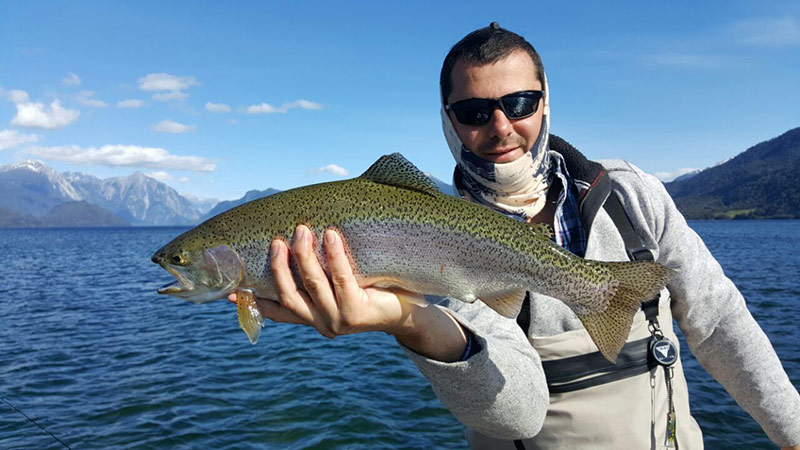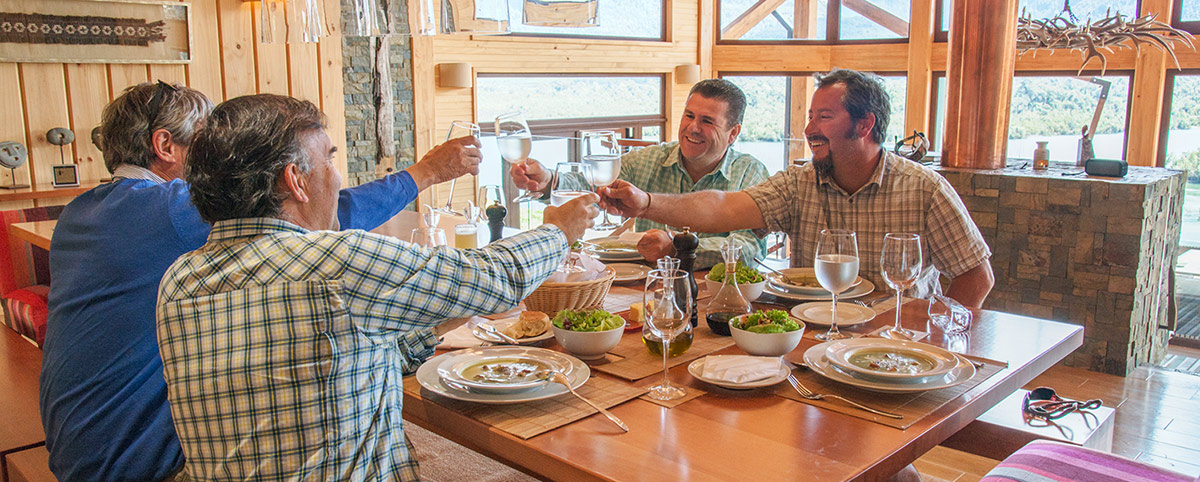Fishing
Fly Fishing in Chile at Chimalfe Patagonia Lodge
Fly fishing at Yelcho Lake is a unique experience. Our waters offer a complete variety of different types of fishing, from big dry flies and weighted streamers to tiny emergers, nymphs and spinners. We fish both floating and sinking lines, dry and wet flies at different times of the season and throughout the day. When fishing the Yelcho and Futaleufu River, much of your fishing will be with streamers and sinking lines. Hatches on much of the river are sporadic and the biggest fish are best drawn out with streamer patterns. There are several sections where nymphs are especially effective, and a tiny spring creek where sight casting to cruising fish can be a delightful change of pace.
Our Season
The fishing season in Chile runs from the beginning of November until the end of April. It is the exact opposite of the North American season, with our longest day of the year falling on December 21. Chimalfe Patagonia Lodge is open for the entire season.
Here’s an idea of what to expect:
Early Season:
Early November – Mid January
These months are often marked by high water, which gradually recedes in December. We’ll start the season fishing lots of weighted streamers on sinking lines. Mayfly and caddis hatches beginning in November will intensify in December providing increasingly better dry fly fishing. Early to middle December will see dragonflies hatching on the lakes and rivers bringing up the biggest fish and providing exciting dry fly action. Dragon fly nymphs and wooly buggers are very effective at this time.
Summer Season:
Late January – Mid March
Excellent evening dry fly action continues into January. The river channels near the lodge feature multiple mayfly and caddis hatches that bring the fish up, especially early and late in the day. As temps warm in February, day time fishing can slow down on both the river and in the lakes. Terrestrials play an increasingly important role in the daily diet as summer progresses.
Fall Season:
Late March – End of April
As Fall approaches, water temperatures begin to cool and the fish become more active. Evening fishing is characterized by a brief flurry of activity right before dark while most daytime fishing is with streamers or large attractor dry flies. Big rubber legged dries work well in the lakes. April is when the big browns become aggressive prior to spawning season.
The Daily Itineary
If you’ve fished with a guide, outfitter or lodge in North America, our daily schedule will feel quite familiar. We are usually out on the water for 9 -10 hours. If you really like to fish, you’ll love the length of our fishing day. For those who consider fishing just one part of a great Patagonia experience, we’re happy to bring you in whenever you’re ready.
Our day begins with breakfast at 8am. After hot coffee, eggs, cereal, fresh fruit or whatever else you need to get going. When the fishermen are ready they are taken to the dock which is 200 meters from the lodge. We will be chasing trout until 1:30 hours or until our clients stomachs begins to rumbling for a hefty Chilean lunch (lunch in Chile is the main meal of the day) on the river banks. A charcoal grilled barbecue or a fire disc is the norm accompanied by salads and some carbs.. Lunch takes up somewhere between 60 to 90 minutes of our time. Since fishing is not obligatory there are clients that prefer to take a nap next to the river, but we’re not surprised if you want to get right back on the water!
After fishing through the afternoon, you would normally get off the water by 7-8 pm or so, and return to the lodge to clean up, take a bath, or perhaps get a bath tub. We serve drinks (beer and wine) and hors d’oeuvres before dinner in front of the fireplace. Dinner is usually served between 9 and 10 o’clock.
Each day will be discussed at dinner time with the head guide and his team thus offering an activity tailor made for each guest..
Fishing Tackle
Fly rods: You should bring at least two fly rods: 5-7 wts for streamer fishing and windier conditions, and a 4-5 wt for evening dry fly fishing. We strongly recommend bringing a third 5 wt as a backup. There are a limited number of rods at the lodge in the event you break one.
Fly reels: Reels should be high quality, preferably disc-drag models loaded with a minimum of 80 / 100 yards of backing. The occasional 8-10 lb fish will test your gear to the limit! You may want a backup reel or extra spools for your reel. Having two rods rigged, one with floating line and one with sinking line will maximize your fishing time.
Lines: Floating and sinking lines cover the fishing. Weight forward or double taper floating lines are fine for dry fly and small streamer fishing. We recommend that you bring a 30 ft 150-250 gram fast sink line for your reel. The fast sinking lines are especially effective in the lakes and the faster, deeper stretches of the river. Most of our lakes have abrupt drop offs along the edges and the sinking lines get the fly down to where the fish are. If you have not cast a fast sinking line before, we recommend you get a little practice in before you come. It’s not difficult to learn, but it will increase your fishing success and pleasure if you already have this technique down.
Leaders: 7 ½ to 9 foot 2x-5x leaders will suffice for most fishing. We like to use fluorocarbon for tippets for its added abrasion resistance and low light reflectivity. Bring some extra spools of tippet in the 2x – 6x range.
Flies: Much of our fishing during the day is with streamers or large attractor pattern dry flies. See the separate fly list for complete recommendations. We do carry a full assortment of productive patterns at the lodge.
Waders: Breathable waders are the best way to maximize your fishing experience. You can layer poly-pro or fleece underneath in cold conditions and turn them down during hot weather.
Wading shoes: Sturdy shoes with good felt or rubber soles. Please be sure your waders and wading shoes are clean and dry before visiting to prevent the spread of invasive species like whirling disease, zebra mussels or didymo. We recommend the new rubber soled wading shoes and waders.
Clothing and Gear
The climate in our part of Patagonia is very similar to the northern United States. You can expect temperatures to range from the mid 40’s early in the season, to the 80’s during the summer months of January through March.
Clothing: Layering is the mantra when fishing. Today’s high tech garments offer almost limitless options for staying warm and dry. Patagonia, Orvis, Simms and others all make clothing specialized for fly fishing. But light cotton sweaters, short and long sleeve shirts and trousers, long underwear, wool sweaters, windbreaker, wool socks, etc. will work as well. Big temperature changes can occur in a matter of hours in the mountains, so make sure you are prepared. Contact us if you have any questions.
Critical Items: A breathable (Gore-Tex or similar) rain jacket, hat, polarized glasses, sunscreen.
Other Items:
- Small day pack or tackle bag
- Fishing Hat
- Polarized Sunglasses
- Digital Camera
- Sun screen and chapstick
- Insect repellent – Buzz Off clothing is very effective











